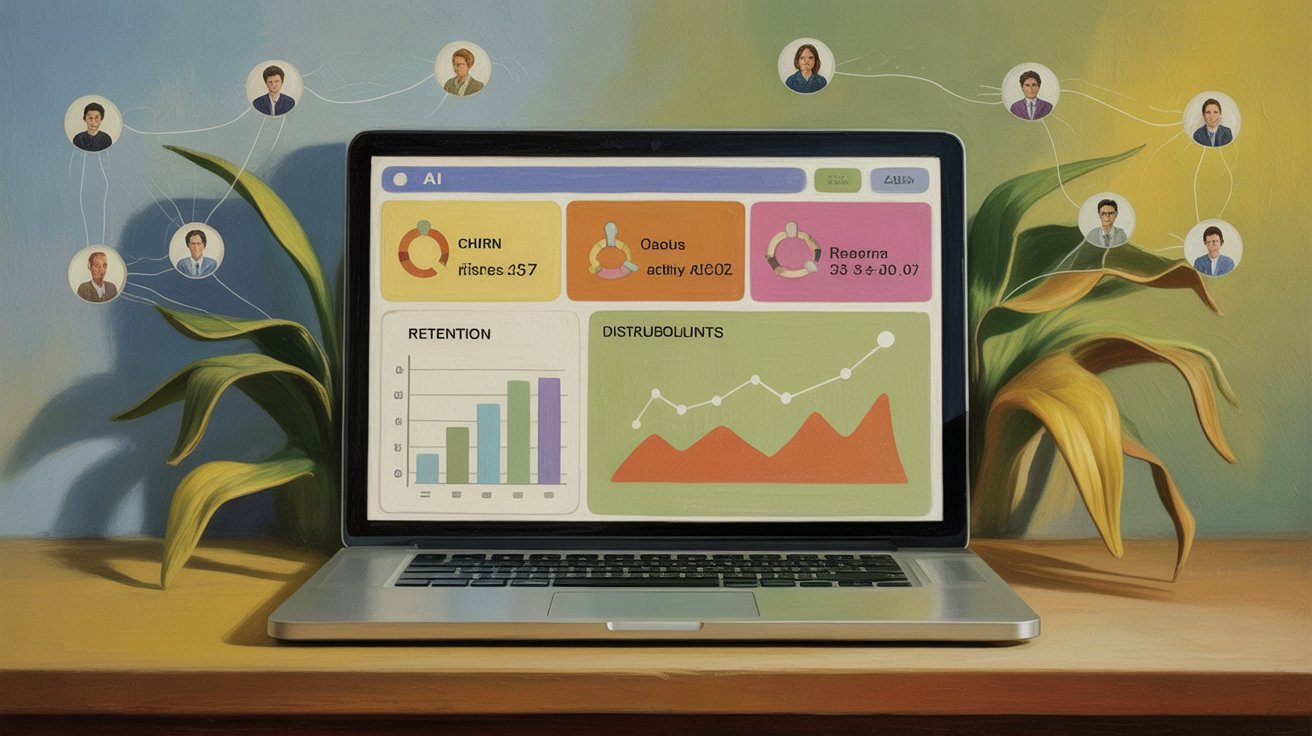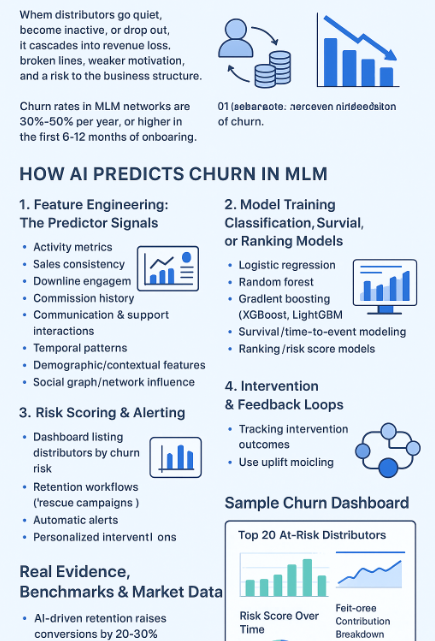

Distributor churn is one of the biggest challenges in multi-level marketing because every lost distributor doesn’t just mean one less seller—it often weakens entire downlines, reduces overall sales volume, and disrupts network growth. High churn rates can erode trust, force companies into costly recruitment cycles, and ultimately threaten long-term stability. Retaining existing distributors is far more cost-effective than replacing them, which is why understanding and reducing churn is critical for sustainable MLM success.
In the world of Multi-Level Marketing (MLM), the strength and continuity of your distributor network is your lifeblood. Unlike conventional sales models, your revenue growth depends heavily on sustained engagement and activity of individual distributors down the line. When distributors go quiet, become inactive, or drop out entirely—that is “churn”—it cascades into revenue loss, broken lines, weaker motivation, and a risk to the entire business structure.
Industry practitioners often cite churn rates in MLM networks of 30%–50% per year—or even more in the first 6–12 months of distributor onboarding. (Note: specific audited public figures are rare due to privacy, but many MLM software vendors and consultants recognize high turnover as a perennial challenge.)
To stay competitive and resilient, modern MLM platforms are increasingly integrating Artificial Intelligence (AI) and Predictive Analytics to detect early signs of “at-risk” distributors and intervene before they churn. Let’s dig into how this works, what’s driving it now (2025), benchmarks, techniques, and where the industry is heading.

AI’s value in churn prediction is its ability to learn complex patterns from historical and real-time data, turning otherwise hidden signals into actionable alerts. Here’s how modern MLM systems often do it:
The first step is to collect signals about distributor behavior. Useful features may include:
Feature engineering often includes lagged features (i.e. values of past weeks or months) and trend features (e.g. slope of decline in activity) to catch gradual disengagement.
Once features are prepared, the system trains a machine learning model to map features → churn risk. Common approaches include:
Research in churn prediction (outside MLM) suggests ensemble models combining tree-based methods and neural networks tend to perform robustly. For example, in a Telecom churn prediction study (2024), an adaptive ensemble that stacked XGBoost, LSTM, SVM and others reached very high accuracies (over 99% in some settings) on public datasets. arXiv
There is also advanced research, such as ChOracle, which models user return times (temporal point processes + recurrent neural nets) to predict not just whether churn occurs, but expected return times after inactivity. arXiv While this is more common for subscription services, analogous techniques can be adapted for MLM.
Once the model outputs a risk score (e.g. probability or “churn score”), the MLM software uses thresholds or percentiles to flag “high risk” distributors. The platform may:
To close the loop, the system tracks which interventions succeed (i.e. prevents churn) and feeds that back into the model. This is often done via uplift modeling (also called “incremental modeling”)—which estimates the causal effect of interventions on retention rather than naive correlation. Uplift modeling is well-known in CRM and churn contexts. Wikipedia
Over time, the system refines which type of incentive or timing is most effective for which type of distributors.
Read in Detail @
Here are some relevant data points, vendor claims, and industry trends:
Though precise public ROI metrics for MLM churn models are sparse (likely due to proprietary privacy of MLM firms), these vendor claims and industry growth indicate that AI-driven retention is becoming a baseline expectation in mature MLM platforms.
Predictive models are powerful, but real-world deployment in MLM environments comes with caveats. Here are common challenges and recommended mitigations:
| Challenge | Mitigation / Best Practice |
|---|---|
| Data sparsity / cold start | New distributors lack history. Use cohort-level features, similarity clustering, or transfer learning from older cohorts. |
| Feature drift / concept drift | Behavior patterns change over time; regularly retrain models (monthly/quarterly) and monitor performance metrics (e.g. AUC, precision). |
| Label ambiguity | Defining “churn” can be fuzzy: complete dropout, prolonged inactivity, or stepped-down status? Establish consistent churn definitions and windows. |
| Intervention bias | If you always intervene on flagged distributors, your model can learn that flagged = saved, biasing labels. Use uplift modeling or randomized control groups. |
| Privacy & data protection | Collect data with consent, anonymize when possible, comply with regulations like GDPR or local data laws. |
| Explainability / trust | Stakeholders (upline leaders, managers) may resist black-box systems. Use interpretable models or SHAP, LIME, feature importance explanations. |
| Integration friction | The churn system must integrate seamlessly with CRM, commission engines, messaging platforms, and dashboards. |
When implemented carefully, these systems move from “nice to have” to “mission critical” as MLM networks scale.
Here are some of the frontier trends and innovations in AI-driven churn prediction for MLM and network-based businesses:
Below is a simplified sketch of what a churn dashboard in a modern AI-MLM system might show:
With this dashboard, leadership, support staff, and uplines can take timely, data-driven actions.
Imagine Distributor A has had solid activity for 3 months, but in month 4, sales decline 40%, and login drops from daily to once every 4 days. The AI model flags this as moderate risk. The system sends:
If the distributor responds or re-engages, the system marks intervention as successful and logs it. Over time, the model learns which types of interventions (timing, incentive amount) are most effective for that class of distributors.
Even a modest churn rate reduction of 5–10% annually can translate into substantial incremental revenue in large MLM systems.
AI-powered churn prediction is rapidly evolving from experimental to essential in MLM software suites. By harnessing behavioral, sales, network, and temporal signals, modern platforms can anticipate who might drop out—and trigger retention paths proactively.
If you’re an MLM operator, here are some strategic steps to adopt:
As AI continues to mature, we’ll see network-aware models, real-time interventions, and deeper personalization take center stage. MLM systems that integrate these capabilities early will build more resilient networks, stronger distributor loyalty, and sustainable growth.
Distributor churn refers to when members of a Multi-Level Marketing (MLM) network become inactive, stop selling products, or leave the company altogether. High churn weakens downlines and leads to revenue loss.
AI analyzes behavioral, sales, and engagement patterns to identify distributors at risk of leaving. It then provides risk scores and triggers automated retention actions, such as personalized training, incentives, or alerts to uplines.
Key data points include sales consistency, login activity, downline growth, commission history, event participation, and communication patterns. Advanced systems also analyze social network effects within MLM hierarchies.
Reduced distributor turnover
Higher sales retention
More efficient resource allocation
Improved distributor engagement and loyalty
Competitive advantage in the direct-selling market
Use of Graph Neural Networks to model downline/upline influence
Personalized “micro-nudges” for engagement
Real-time predictive alerts with automated interventions
Integration of voice/sentiment analytics for better distributor insights
Yes. Many modern MLM software providers now include AI-driven churn alerts and retention dashboards as standard features, making predictive analytics accessible even to smaller businesses.
Accuracy depends on data quality and algorithms used, but advanced models like ensemble learning or survival analysis can achieve predictive accuracies above 85–90%, according to industry benchmarks.